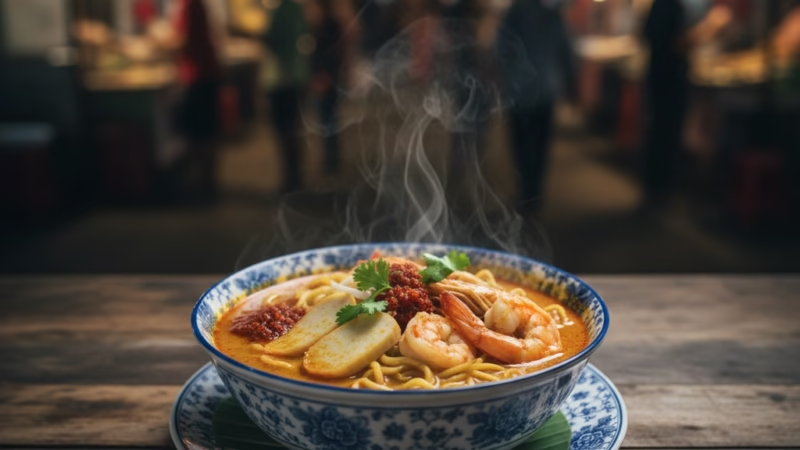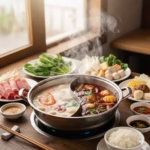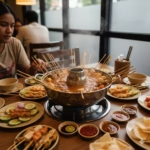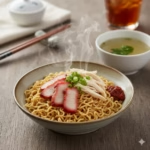Curry Laksa

Malaysian Food
Curry Laksa
Origin
Malaysia and Singapore; part of Peranakan (Nyonya) cuisine.
Category
Noodle soup / Spicy coconut curry soup
Appearance
Bright orange or reddish broth with noodles, tofu puffs, boiled eggs, prawns or chicken, garnished with bean sprouts and fresh herbs.
Ingredients
- Noodles: rice vermicelli, egg noodles, or combination
- Protein: chicken, prawns, fish cakes, tofu puffs
- Coconut milk
- Laksa paste: chili, shallots, garlic, lemongrass, galangal, turmeric, dried shrimp paste
- Garnishes: bean sprouts, boiled egg, fresh coriander, lime, fried shallots
- Optional: cockles, fish balls
Preparation
- Blend aromatics and spices into laksa paste.
- Fry paste in oil until fragrant.
- Add coconut milk and stock; simmer to develop flavors.
- Cook noodles separately.
- Add proteins to the soup.
- Assemble noodles in bowls, pour over broth, and garnish.
Equipment
- Blender or mortar and pestle
- Wok or saucepan
- Pots for boiling noodles
- Serving bowls
Variations
- Curry Laksa (Nyonya style, coconut-based)
- Asam Laksa (tamarind-based, sour)
- Dry Laksa (stir-fried noodles with laksa paste)
Taste
Spicy, creamy, savory, slightly sweet with herbal notes.
Texture
Smooth, rich broth; soft noodles; firm proteins; crunchy garnishes.
Aroma
Fragrant with coconut, lemongrass, chili, and spices.
Sound
Gentle bubbling during cooking; soft slurping when eating.
Cultural Significance
Beloved dish among Peranakan communities; fusion of Chinese and Malay culinary traditions.
Symbolism
Represents multicultural heritage; often served during gatherings and festive occasions.
Regional Cuisine
Common in Penang, Malacca, Singapore; found in Malaysian and Singaporean Peranakan restaurants worldwide.
Social Context
Popular street food and comfort food; served in hawker centers and restaurants.
Nutritional Information
High in calories due to coconut milk; moderate protein; fiber from vegetables.
Health Benefits
Provides protein and vitamins from herbs and vegetables.
Dietary Restrictions
Not vegan if using shrimp paste or chicken; gluten-free if rice noodles are used.
Allergens
Seafood, shellfish, gluten (if wheat noodles used), coconut.
Cost
Moderate; varies with protein and location.
Production
Made fresh daily in hawker centers or restaurants; homemade variations common.
Sustainability
Can use sustainable seafood and local herbs to reduce environmental impact.
Availability
Widely available in Malaysia, Singapore, and in Peranakan restaurants globally.
History
Originated from Peranakan communities, combining Chinese noodles with Malay curry spices.
Anecdotes
Considered a comfort food; evokes nostalgia for locals and travelers alike.
How to Prepare
- Make or buy laksa paste.
- Simmer with coconut milk and stock.
- Cook noodles and proteins separately.
- Serve noodles in bowls, pour over soup, garnish.
FAQ
Q: Can it be made less spicy?
A: Reduce chili in the laksa paste.
Q: Can I store it?
A: Broth can be refrigerated 2–3 days; noodles are best cooked fresh.
Q: Can I use other proteins?
A: Yes — chicken, tofu, fish, or vegetarian alternatives work.















Comments are closed.